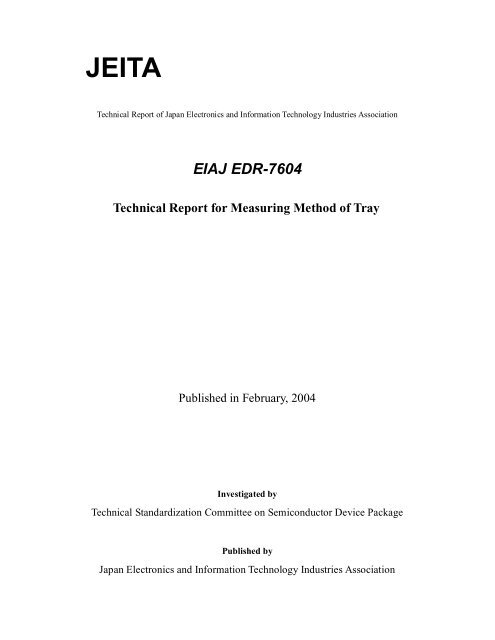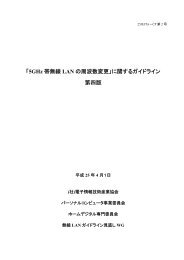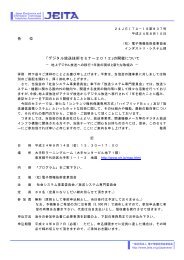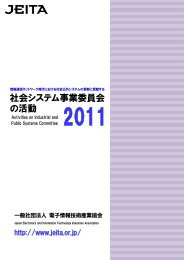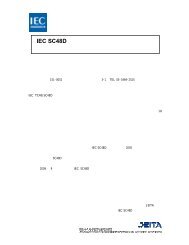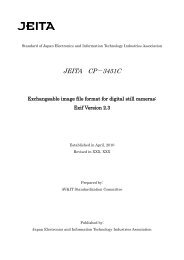EIAJ EDR-7604 - JEITA
EIAJ EDR-7604 - JEITA
EIAJ EDR-7604 - JEITA
Create successful ePaper yourself
Turn your PDF publications into a flip-book with our unique Google optimized e-Paper software.
<strong>JEITA</strong><br />
Technical Report of Japan Electronics and Information Technology Industries Association<br />
<strong>EIAJ</strong> <strong>EDR</strong>-<strong>7604</strong><br />
Technical Report for Measuring Method of Tray<br />
Published in February, 2004<br />
Investigated by<br />
Technical Standardization Committee on Semiconductor Device Package<br />
Published by<br />
Japan Electronics and Information Technology Industries Association
This document is a translation without guarantee. In the event of any doubt arising,<br />
the original standard in Japanese is to be evidenced.<br />
<strong>JEITA</strong> standards are established independently to any existing patents on the<br />
products, materials or processes they cover.<br />
<strong>JEITA</strong> assumes absolutely no responsibility toward parties applying these<br />
standards or toward patent owners.<br />
C 2004 by the Japan Electronics and Information Technology Industries Association<br />
All rights reserved. No part of this standard may be reproduced in any form or by<br />
any means without prior permission in writing from the publisher.
1. Scope<br />
- 1 -<br />
<strong>EIAJ</strong> <strong>EDR</strong>-<strong>7604</strong><br />
Technical report of Japan Electronics and Information Technology Industries Association<br />
Technical Report for Measuring Method of Tray<br />
This technical report is applied to the tray based on tray standard enacted by <strong>JEITA</strong>.<br />
2. Definition of terms<br />
Definition of main terms in this report shall conform with <strong>EIAJ</strong> ED-7300 [Recommended practice on<br />
standard for the preparation of outline drawings of semiconductor packages].<br />
New terms will be defined in the descriptions of this report.<br />
3. History<br />
As for the dimension of the tray for the integrated circuit (IC) package, it is prescribed in the independent<br />
standard and the design guide. However, the enacted tray dimensions have been measured in a variety of<br />
methods by each company. Therefore, a measurement result was different, and a problem occurred<br />
between tray manufacturer and users (semiconductor manufacturer). Since the miniaturization trend of<br />
semiconductor packages will result in more complicated tray structure in the future, the correspondence<br />
between the date measured by the semiconductor manufacturer and ones measured by the tray supplier<br />
are important.<br />
This technical report is specifies to make the definitions of enacted dimensions clear and to standardize<br />
measurement method of them. This technical report is applied to the tray based on tray standard enacted<br />
by <strong>JEITA</strong>.
(2) Measurement method (Refer to Figure 8)<br />
(A) When it is measured with calipers<br />
The length dimension L2 is the maximum value around a-a and b-b.<br />
The width dimension W1 is the maximum value around d-d, e-e and f-f.<br />
- 5 -<br />
<strong>EIAJ</strong> <strong>EDR</strong>-<strong>7604</strong><br />
The length dimension L1 should be measured at only one point around the center department c-c.<br />
(B) When it is measured with an optical apparatus (two dimensions, three dimensions).<br />
The length dimension L2 is the maximum value around a-a and b-b.<br />
The width dimension W1 is the maximum value around d-d, e-e and f-f.<br />
The length dimension L1 should be measured around the center line c-c.<br />
Figure 8
6.3 Stack dimension L3, L4, W2, W3<br />
(1) Definition<br />
Stack dimension of overlapping portions of stacked trays is defined as stack dimensions.<br />
From the function L3 and W2 make the maximum value, L4 and W3 make the minimum value.<br />
(2) Measurement method (Refer to Figure 10)<br />
(A) When it is measured with calipers<br />
L3 and W2 are the maximum values around [a-a, b-b, c-c] and [d-d, e-e, f-f], respectively.<br />
L4 and L3 can not be measured precisely with calipers.<br />
(B) When it is measured with an optical apparatus (two-dimensions, three dimensions).<br />
L3 and W2 are the maximum values around [a-a, b-b, c-c] and [d-d, e-e, f-f], respectively.<br />
L4 and W3 are the maximum values around [a-a, b-b, c-c] and [d-d, e-e, f-f], respectively.<br />
The dimensions should be measured approximately 10 mm from the edge.<br />
Figure 10<br />
- 7 -<br />
<strong>EIAJ</strong> <strong>EDR</strong>-<strong>7604</strong>


